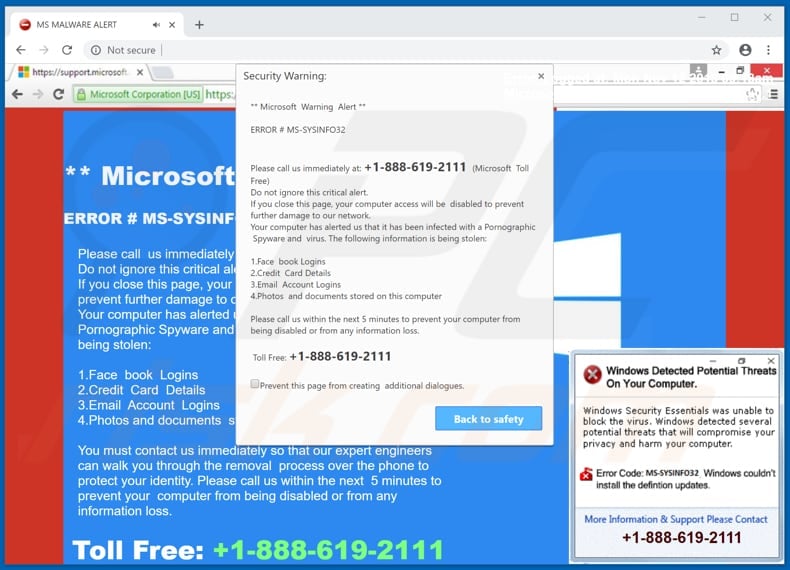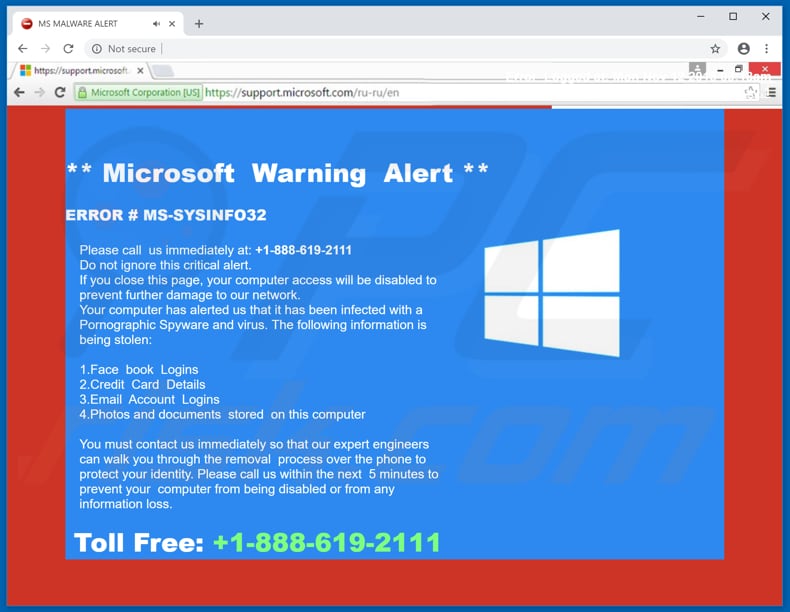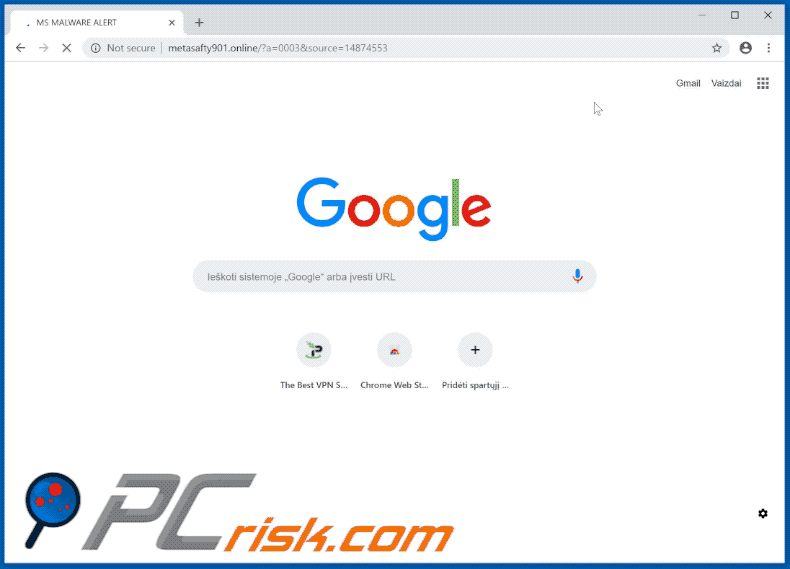Get free scan and check if your device is infected.
Remove it nowTo use full-featured product, you have to purchase a license for Combo Cleaner. Seven days free trial available. Combo Cleaner is owned and operated by RCS LT, the parent company of PCRisk.com.
What is "MS MALWARE ALERT"?
"MS MALWARE ALERT" is a fake virus alert similar to many others of this type. It is displayed on untrustworthy, deceptive websites that most people visit unintentionally - they are redirected by potentially unwanted applications (PUAs). In many cases, users install these apps inadvertently.
Once installed, PUAs deliver intrusive advertisements and record data relating to browsing activity. The "MS MALWARE ALERT" fake message is presented in text and audio formats.

According to the "MS MALWARE ALERT" fake virus message, there are security problems with the user's Windows computer and a "ERROR # MS-SYSINFO32" error has occurred.
Scammers behind the "MS MALWARE ALERT" error imply that your computer has been infected with spyware and that your Facebook/email logins, credit card details, photos, and other data has been stolen. They also claim that if you ignore this "critical alert", your computer will be disabled.
Furthermore, these scammers claim to be 'Microsoft technicians' (support team) and urge users to contact them via the telephone number +1-888-619-2111 provided. When contacted, they attempt to trick people into paying for their 'services' or purchasing software that will supposedly remove viruses, fix errors, etc.
Note that "MS MALWARE ALERT" is a typical scam and you are strongly advised to ignore it. Simply close the browser window and avoid returning to the website. If it prevents you from closing the site, use Task Manager to end the entire browser process.
Another way to close it is to simply restart your computer. Make sure you do not visit the website again (do not restore the closed session).
Potentially unwanted applications that lead to websites of this type are also designed to deliver intrusive ads and gather data. The ads are often various coupons, banners, surveys, and other similar ads. They are usually displayed via tools that enable placement of third party graphical content on any site.
They conceal underlying content of any visited website, which can be annoying. Furthermore, if clicked, the ads often redirect to untrustworthy sites. These redirects can lead to installation of other potentially unwanted applications.
Furthermore, unwanted apps of this type record IP addresses, search queries, keystrokes, URLs of visited websites, and other browsing-related data, some of which might include sensitive/personal details. PUA developers share the collected data with third parties (potentially, cyber criminals) who misuse it to generate revenue.
Thus, having data tracking applications installed might cause privacy or browsing safety issues, or even greater problems such as identity theft.
| Name | "MS MALWARE ALERT" virus |
| Threat Type | Phishing, Scam, Social Engineering, Fraud |
| Symptoms | Unauthorized online purchases, changed online account passwords, identity theft, illegal access of one's computer. |
| Distribution methods | Deceptive emails, rogue online pop-up ads, search engine poisoning techniques, misspelled domains. |
| Damage | Loss of sensitive private information, monetary loss, identity theft. |
| Malware Removal (Windows) |
To eliminate possible malware infections, scan your computer with legitimate antivirus software. Our security researchers recommend using Combo Cleaner. Download Combo CleanerTo use full-featured product, you have to purchase a license for Combo Cleaner. 7 days free trial available. Combo Cleaner is owned and operated by RCS LT, the parent company of PCRisk.com. |
The internet is full of deceptive websites that are designed to display fake virus, error, and other alerts/messages. Some examples of other similar fake alerts are Your Computer Was Locked, Error # 0xx90025ee9, and System Firewall Has Blocked Some Features.
All of these fake messages are used by scammers to trick people into paying for solving problems that do not exist. Potentially unwanted applications also share many similarities. Most are promoted as 'useful tools', but these are only attempts to trick people into downloading them.
Furthermore, these apps deliver none of the functionality promised and are designed only to generate revenue for their developers by feeding users with advertisements and recording browsing-related (and other) data.
How did potentially unwanted applications install on my computer?
Some potentially unwanted apps can be downloaded from their official websites, however, in most cases, people install them inadvertently by clicking intrusive advertisements or they are installed together with other software. To trick users into installing unwanted apps, developers use the "bundling" method.
They hide "bundled" PUAs in "Custom", "Advanced" and other similar sections of the download/installation processes. In summary, developers avoid disclosing information about the inclusion of unwanted apps in the download/installation set-ups. They are aware that many users skip installation steps without checking available settings, and they use this to their advantage.
How to avoid installation of potentially unwanted applications?
Avoid using third party software downloaders (and installers) such as torrents and other similar software. Download software using official and trustworthy sources/websites. Do not skip installation steps without first checking "Custom"/"Advanced" settings. Deselect unwanted offers/features (such as potentially unwanted apps) and only then finish the installation.
Be cautious when browsing the web, avoid clicking intrusive ads, especially when visiting dubious websites. If you are often redirected to untrustworthy websites (pornography, adult dating, gambling, and so on), check your browser extensions, plug-ins, and add-ons for suspicious entries.
The same applies to programs installed on your computer. Remove all unknown/unwanted entries immediately. If your computer is already infected with PUAs, we recommend running a scan with Combo Cleaner Antivirus for Windows to automatically eliminate them.
Website displaying MS MALWARE ALERT" pop-up:

Text presented in "MS MALWARE ALERT" pop-up and website:
Security Warning:
** Microsoft Warning Alert **ERROR # MS-SYSINFO32
Please call us immediately at: +1-888-619-2111 (Microsoft Toll Free)
Do not ignore this critical alert.
If you close this page, your computer access will be disabled to prevent further damage to our network.
Your computer has alerted us that it has been infected with a Pornographic Spyware and virus. The following information is being stolen:1.Face book Logins
2.Credit Card Details
3.Email Account Logins
4.Photos and documents stored on this computerPlease call us within the next 5 minutes to prevent your computer from being disabled or from any information loss.
Toll Free: +1-888-619-2111
Prevent this page from creating additional dialogues.
Text presented in a side pop-up (bottom-right corner):
Windows Detected Potential Threats On Your Computer
Windows Security Essentials was unable to block the virus. Windows detected several potential threats that will compromise your privacy and harm your computer.
Error Code: MS-SYSINFO32 Windows couldn't install the definition updates.
More Information & Support Please Contact
+1-888-619-2111
The appearance of "MS MALWARE ALERT" pop-up (GIF):

Instant automatic malware removal:
Manual threat removal might be a lengthy and complicated process that requires advanced IT skills. Combo Cleaner is a professional automatic malware removal tool that is recommended to get rid of malware. Download it by clicking the button below:
DOWNLOAD Combo CleanerBy downloading any software listed on this website you agree to our Privacy Policy and Terms of Use. To use full-featured product, you have to purchase a license for Combo Cleaner. 7 days free trial available. Combo Cleaner is owned and operated by RCS LT, the parent company of PCRisk.com.
Quick menu:
- What is "MS MALWARE ALERT" virus?
- How to identify a pop-up scam?
- How do pop-up scams work?
- How to remove fake pop-ups?
- How to prevent fake pop-ups?
- What to do if you fell for a pop-up scam?
How to identify a pop-up scam?
Pop-up windows with various fake messages are a common type of lures cybercriminals use. They collect sensitive personal data, trick Internet users into calling fake tech support numbers, subscribe to useless online services, invest in shady cryptocurrency schemes, etc.
While in the majority of cases these pop-ups don't infect users' devices with malware, they can cause direct monetary loss or could result in identity theft.
Cybercriminals strive to create their rogue pop-up windows to look trustworthy, however, scams typically have the following characteristics:
- Spelling mistakes and non-professional images - Closely inspect the information displayed in a pop-up. Spelling mistakes and unprofessional images could be a sign of a scam.
- Sense of urgency - Countdown timer with a couple of minutes on it, asking you to enter your personal information or subscribe to some online service.
- Statements that you won something - If you haven't participated in a lottery, online competition, etc., and you see a pop-up window stating that you won.
- Computer or mobile device scan - A pop-up window that scans your device and informs of detected issues - is undoubtedly a scam; webpages cannot perform such actions.
- Exclusivity - Pop-up windows stating that only you are given secret access to a financial scheme that can quickly make you rich.
Example of a pop-up scam:

How do pop-up scams work?
Cybercriminals and deceptive marketers usually use various advertising networks, search engine poisoning techniques, and shady websites to generate traffic to their pop-ups. Users land on their online lures after clicking on fake download buttons, using a torrent website, or simply clicking on an Internet search engine result.
Based on users' location and device information, they are presented with a scam pop-up. Lures presented in such pop-ups range from get-rich-quick schemes to fake virus scans.
How to remove fake pop-ups?
In most cases, pop-up scams do not infect users' devices with malware. If you encountered a scam pop-up, simply closing it should be enough. In some cases scam, pop-ups may be hard to close; in such cases - close your Internet browser and restart it.
In extremely rare cases, you might need to reset your Internet browser. For this, use our instructions explaining how to reset Internet browser settings.
How to prevent fake pop-ups?
To prevent seeing pop-up scams, you should visit only reputable websites. Torrent, Crack, free online movie streaming, YouTube video download, and other websites of similar reputation commonly redirect Internet users to pop-up scams.
To minimize the risk of encountering pop-up scams, you should keep your Internet browsers up-to-date and use reputable anti-malware application. For this purpose, we recommend Combo Cleaner Antivirus for Windows.
What to do if you fell for a pop-up scam?
This depends on the type of scam that you fell for. Most commonly, pop-up scams try to trick users into sending money, giving away personal information, or giving access to one's device.
- If you sent money to scammers: You should contact your financial institution and explain that you were scammed. If informed promptly, there's a chance to get your money back.
- If you gave away your personal information: You should change your passwords and enable two-factor authentication in all online services that you use. Visit Federal Trade Commission to report identity theft and get personalized recovery steps.
- If you let scammers connect to your device: You should scan your computer with reputable anti-malware (we recommend Combo Cleaner Antivirus for Windows) - cyber criminals could have planted trojans, keyloggers, and other malware, don't use your computer until removing possible threats.
- Help other Internet users: report Internet scams to Federal Trade Commission.
Share:

Tomas Meskauskas
Expert security researcher, professional malware analyst
I am passionate about computer security and technology. I have an experience of over 10 years working in various companies related to computer technical issue solving and Internet security. I have been working as an author and editor for pcrisk.com since 2010. Follow me on Twitter and LinkedIn to stay informed about the latest online security threats.
PCrisk security portal is brought by a company RCS LT.
Joined forces of security researchers help educate computer users about the latest online security threats. More information about the company RCS LT.
Our malware removal guides are free. However, if you want to support us you can send us a donation.
DonatePCrisk security portal is brought by a company RCS LT.
Joined forces of security researchers help educate computer users about the latest online security threats. More information about the company RCS LT.
Our malware removal guides are free. However, if you want to support us you can send us a donation.
Donate
▼ Show Discussion